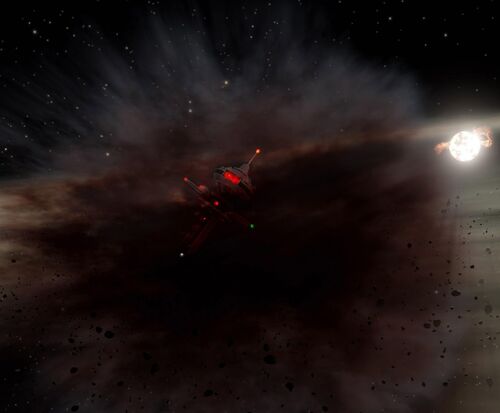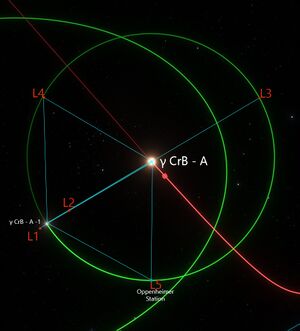Oppenheimer Station
| Oppenheimer Station | |
| Information | |
| Class | |
| Affiliation |
Independant (Formerly United Federation of Planets) |
| Status | Active |
| Commissioned | 2368 |
| Location | |
| System | Gamma Coronae Borealis |
| Sector | Deneb Sector |
| Quadrant | Alpha Quadrant |
| Assignment | |
| Role |
Research Outpost |
| Template:Starbase | |
Oppenheimer Station (also known as Oppenheimer Research Outpost) is a Regula Class station located in the Gamma Coronae Borealis system (abbreviated γ CrB).
The facility is fairly unusual in that it is anchored at the trailing L5 Lagrange point with its two parent bodies being the γ CrB - A star and the γ CrB - A1 planet . Over millennia the L5 Lagrange point has accumulated a large amount of stellar debris and dust resulting in the formation of a large Ionised dust cloud that resembles a small micro-nebula
Location
Oppenhiemer station is located in the Gamma Coronae Borealis system which is approximately 18 Light years coreward from Farpoint Station.
γ CrB is a binary star system containing a primary star ( γ CrB - A) of spectral classification F7 V and a secondary star ( γ CrB - B) of spectral classification M5 V.Orbital Characteristics
Oppenheimer station occupies the L5 Lagrange point in the orbit of γ CrB - A1. There are usually 5 Lagrange points where the gravitational pull of two massive bodies precatively match the centripetal required for a small object to move with them. In effect this allows a small object (a small station or starship) to remain fixed in space relative to its two parent bodies, with little to no additional energy required for station keeping. The L1. L2 and L3 points are considered "Unstable" and require very precise manoeuvring in order to occupy them for any length of time. The L4 and L5 points are much larger and are considered "Stable". They can accumulate matter and debris easily and retain it indefinitely due to the gravitational forces being at equilibrium in these regions; The L5 Lagrange point in particular has accumulated a large amount of stellar debris, forming a dense cloud of Ionised dust. Oppenheimer station is located within this cloud.
L5 Lagrange Cloud Hazards
The cloud of dust that surrounds the station is mostly made up of water ice, micro meteorites, trace gasses and various pulverised minerals. The matter in the cloud has a very low velocity relative to the station however friction with the station causes a measurable static charge to build up inside the cloud. The electrostatic potential across the cloud can vary greatly to the point that it equalises violently in the form of an electrostatic discharge.
This electrostatic discharge can be a hazard for approaching vessels, especially when approaching and departing the station. Careful attention must be given to the build up of charge along a ships hull, relative to that of the surrounding environment and the station itself. The hazard can be mitigated by polarising the hull of a ship to repel the negatively charged matter of the cloud. Deflector shields are largely ineffective at protecting a ship from this phenomena unless precisely calibrated and in any case this does not prevent a vessel from being struck by an electrostatic discharge.
Another property of the cloud is that due to its density it serves as an excellent shield for stellar radiation - this is the primary desirable effect of the cloud that lead to the installation of Oppenheimer station in 2369. Its only drawback is that much like stellar nebulae - ship sensors operate with reduced fidelity due to interference. This can be a navigational hazard when approaching the station and most ships have to rely on navigational buoy's to guide them safely in to dock.
Finally due to the nature of Lagrange points, larger asteroids and debris can sometimes be captured by the region and either orbit around or enter the cloud completely, while these objects pose little issue when outside the cloud's perimeter, they can be an extreme navigational hazard should they enter the cloud and become concealed. Oppenheimer station is responsible for tracking most objects in the vicinity of the station and if one becomes a hazard, it is usually detected and tugs dispatched to tow it away from any trajectory that would jeopardise the station or shipping lanes


